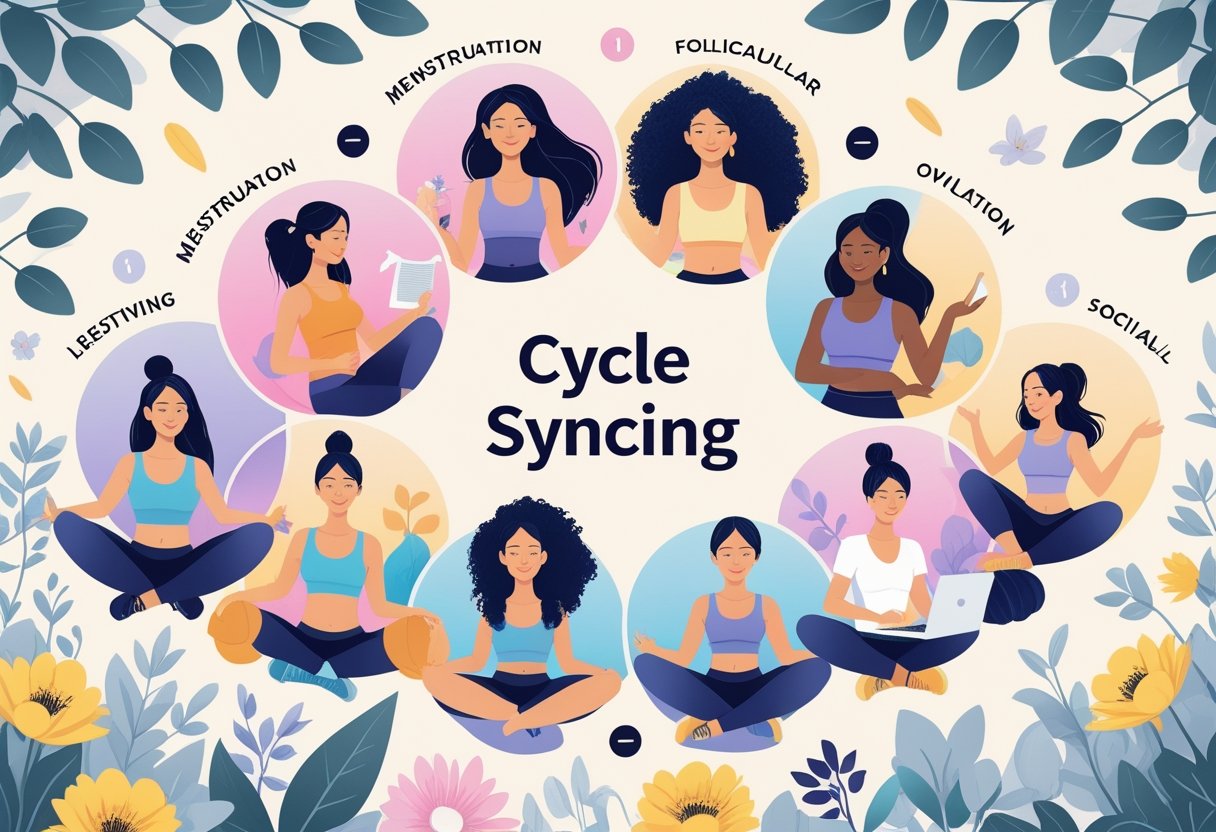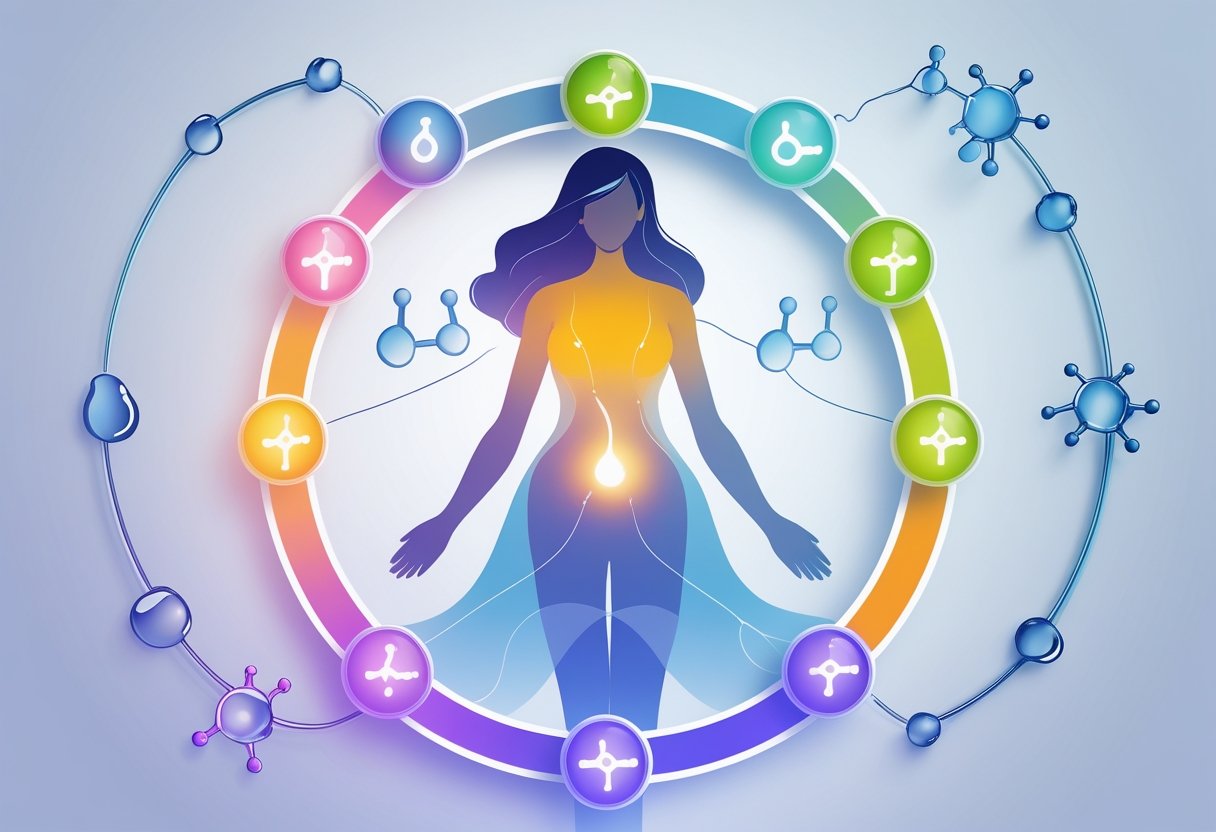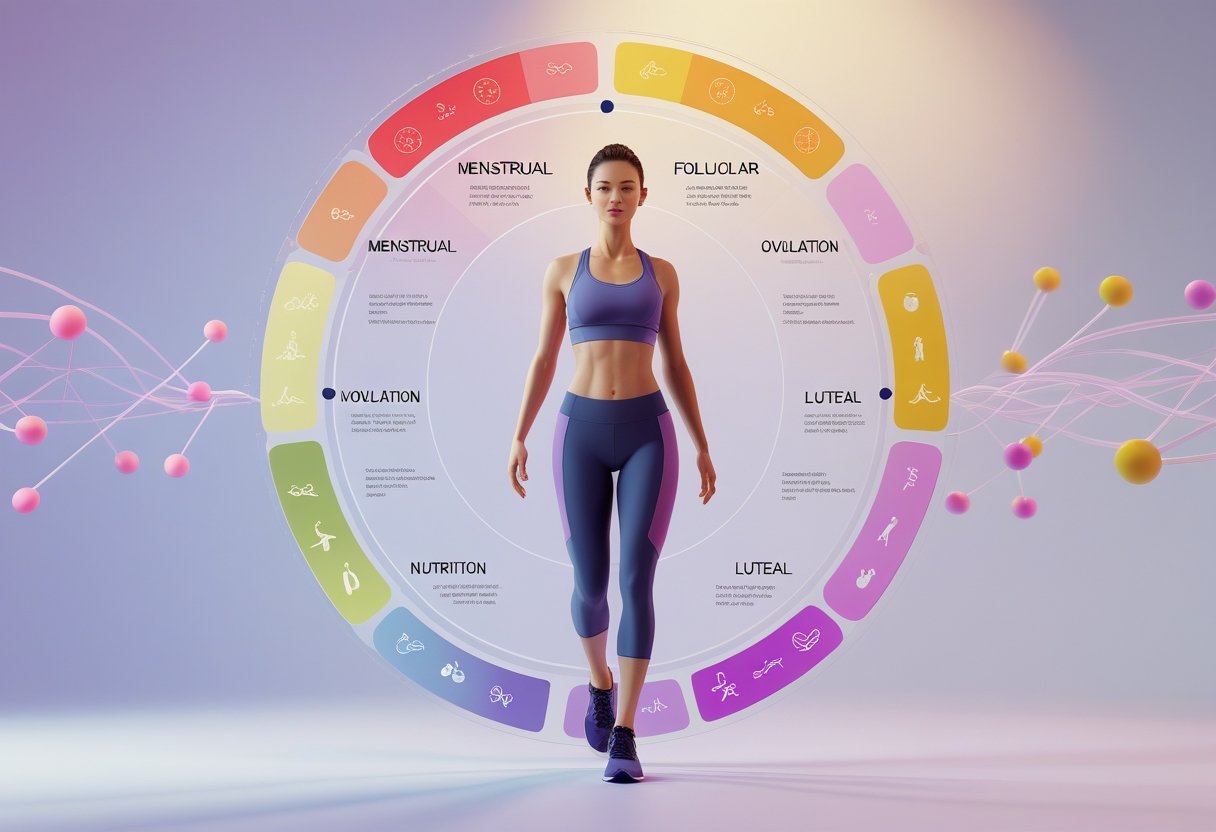Cycle syncing is a method where women adjust their diet, exercise, and daily habits to align with the different phases of their menstrual cycle. This approach may help women manage their bodies and feel better during the month by paying attention to hormonal changes and making small lifestyle shifts.
More people are talking about cycle syncing as a possible way to handle symptoms like fatigue, mood changes, and low motivation, which can show up at different times in the cycle.

Understanding the basics of cycle syncing can make it easier for women to support their health. By paying attention to the menstrual phases, women can choose foods, workouts, and routines that fit how they feel each week. For example, some find it useful to balance their energy by syncing workouts with their hormone levels instead of doing the same thing every day. To learn more about cycle syncing and how these adjustments work, visit this detailed guide on cycle syncing.
Key Takeaways
- Cycle syncing supports women's health by matching habits with the menstrual cycle.
- Adjusting nutrition and exercise based on cycle phases may help manage symptoms.
- Understanding hormonal changes makes it easier to build routines that work.
Understanding the Menstrual Cycle
The menstrual cycle is a repeating process that prepares the body for possible pregnancy each month. Changes in hormone levels help guide this cycle, affecting physical health, mood, and energy.
Phases of the Menstrual Cycle
The menstrual cycle divides into four main phases: menstruation, follicular phase, ovulation, and luteal phase.
Menstruation is the first phase, when the uterus sheds its lining. Most periods last 3 to 7 days.
After menstruation, the follicular phase begins. Follicles in the ovaries start to mature, preparing an egg for release.
Ovulation occurs about halfway through the cycle, usually around day 14 in a 28-day cycle. One mature egg is released from the ovary.
During the luteal phase, the body prepares for a possible pregnancy. If the egg is not fertilized, hormone levels drop, and the cycle starts again with menstruation.
| Phase | Main Event | Typical Duration |
|---|---|---|
| Menstruation | Shedding blood/lining | 3-7 days |
| Follicular | Egg matures | 7-21 days (varies) |
| Ovulation | Egg released | 1 day |
| Luteal | Prepares for pregnancy | 12-16 days |
Hormonal Changes Throughout the Cycle
Hormonal fluctuations drive each phase of the menstrual cycle.
Estrogen rises during the follicular phase to help the egg mature. Estrogen also helps rebuild the uterine lining after menstruation.
Luteinizing hormone (LH) and follicle-stimulating hormone (FSH) increase near ovulation. LH triggers the release of the egg from the ovary.
During the luteal phase, progesterone rises. It supports the uterine lining so a fertilized egg could implant and grow.
If there is no pregnancy, both estrogen and progesterone levels fall. This hormonal change causes the uterine lining to shed, starting menstruation.
Menstrual Cycle and Hormonal Health
Hormonal balance is important for a healthy menstrual cycle.
Signs of imbalances can include irregular periods, very heavy bleeding, or skipped cycles. These symptoms could point to issues like polycystic ovary syndrome (PCOS) or thyroid problems. Cycle syncing as a method to support hormonal health involves changing nutrition, exercise, and other lifestyle habits to accommodate the different phases.
Tracking cycles with an app or journal can help spot patterns or problems. If symptoms are severe or cycles are very irregular, a healthcare provider should evaluate for underlying hormonal problems.
What Is Cycle Syncing?
Cycle syncing is the practice of changing daily routines, including food, exercise, and work, to match the menstrual cycle’s hormonal changes. This approach may support hormone health and help women manage symptoms by responding to the needs of each cycle phase.
How Cycle Syncing Works
Cycle syncing is based on the four main phases of the menstrual cycle: menstrual, follicular, ovulatory, and luteal.
Each phase has unique hormone shifts. For example, during the follicular phase, rising estrogen often leads to higher energy levels. In the luteal phase, progesterone increases, which might cause women to feel more tired or experience cravings.
With this method, women adjust what they eat, how they exercise, and even their sleep or work habits throughout the month. For instance, they might choose lighter workouts and nourishing foods during menstruation but do more intense exercise when energy is higher later in the cycle.
Changing routines in response to hormone changes can help women feel more in tune with their bodies and manage symptoms more effectively. For more details, see how cycle syncing is explained.
Benefits for Women's Health
Cycle syncing may support overall women’s health by working with the body’s hormone patterns instead of against them.
Possible benefits include less severe PMS, more stable moods, and improved energy levels. Some women report fewer cravings, easier periods, or even better mental health by aligning their routines with hormone changes.
Women with specific health concerns, like polycystic ovary syndrome (PCOS) or irregular periods, sometimes find this approach helpful for managing symptoms. However, research is still ongoing, and results can vary for each person. More information on the impact of cycle syncing on women’s wellness is found in this detailed guide.
Hormonal Phases and Exercise
Hormones change across the menstrual cycle and can influence how the body responds to different types of workouts. Matching exercise choices to each phase may help with comfort, recovery, and making progress.
Follicular Phase Workouts
The follicular phase is the first part of the cycle, starting right after menstruation and lasting until ovulation. During these days, estrogen levels increase, often leading to improved energy and mood. Many people find it easier to do higher-intensity workouts at this time.
Key exercises for the follicular phase may include:
- Cardio (running, cycling, swimming)
- Strength training (weight lifting, resistance bands)
- High-intensity interval training (HIIT)
Strength gains can be easier to achieve, and recovery may be slightly faster. This is a good time for trying new workouts or aiming for harder fitness goals. More about adjusting exercise routines for this phase can be found in this guide on cycle syncing.
Ovulation and Performance
Ovulation marks the middle of the cycle. Estrogen peaks and some folks feel their strongest and most powerful during these few days. Athletic performance often reaches its highest level, making it a good period for personal records or competing.
Workouts that match well with ovulation include:
- High-intensity strength training
- Explosive exercises (sprints, plyometrics)
- Competitive sports
Flexibility is also best during this window. However, there’s also a slight increase in injury risk, especially for the knees. Warming up well and maintaining good form can lower this risk. More details are provided in this article on training for your cycle.
Luteal Phase Training Adjustments
The luteal phase comes after ovulation and ends when the next period starts. Progesterone rises, which may cause lower energy, more fatigue, or mood changes. Bloating and discomfort are also possible.
Recommended workouts during the luteal phase:
- Moderate cardio (walking, steady cycling)
- Lower intensity strength routines
- Mobility and stretching sessions (yoga, pilates)
- Hot yoga for relaxation
Taking rest days or being gentle with workout intensity can help the body recover. This phase is best for maintaining routines, focusing on form, and avoiding overdoing high-impact activity. For more on how to align habits with hormonal changes, read this cycle syncing guide.
Hormones Influencing Cycle Syncing

Hormonal changes during the menstrual cycle affect energy, muscle recovery, and workout performance. Understanding how estrogen, progesterone, and testosterone work helps people adjust their exercise and wellness routines to fit their body's needs.
Estrogen and Energy Levels
Estrogen rises in the first half of the menstrual cycle, especially during the follicular phase. During this time, many people feel more energetic and have better endurance. This is because estrogen supports the use of carbohydrates for fuel and may help muscles recover faster after workouts.
High estrogen levels often lead to improved mood and focus. People may notice they can handle more intense activities, such as running, interval training, or aerobics. Studies suggest coordination might even improve when estrogen peaks.
These changes are important for anyone planning exercise routines around their cycle. It’s a good time to try new workouts or increase training loads, as the body is generally more adaptable and resilient. Learn more about estrogen's effects at WebMD’s guide to cycle syncing.
Progesterone's Role in Recovery
Progesterone rises after ovulation, during the luteal phase. At this stage, many notice a drop in energy and may feel more tired or sluggish. Progesterone makes the body less efficient at using carbohydrates for quick energy, so endurance can become harder.
This phase may lead to more muscle soreness after exercise. Recovery tends to slow down as the hormonal load increases. Small injuries can take a bit longer to heal, and heavy lifting sessions might feel tougher than usual.
Light to moderate activities like walking, yoga, and swimming can help during this time. Focusing on sleep and gentle movement supports the body's natural recovery process. Progesterone's impact is discussed in detail at Banner Health’s overview of cycle syncing.
Testosterone and Muscle Growth
Although testosterone is a key male hormone, it also plays a role in the female cycle. Levels tend to be higher around ovulation. During this time, some people notice increased strength and muscle gains.
Higher testosterone supports muscle growth and repair, making strength training more effective. It can also lead to increased motivation and physical drive. During this stage, doing resistance workouts or trying to set new personal records may yield better results.
Tracking these changes allows people to match their workouts with times when their hormonal balance best supports building muscle. Testosterone’s impact is explained further at The Honeypot’s guide on hormone alignment.
Impact of Cycle Syncing on Physical and Mental Health

Cycle syncing helps people respond to changes that happen in the body each month. Hormonal fluctuations across the menstrual cycle can influence mood, energy levels, and metabolism in specific, noticeable ways.
Mood and Endorphin Response
Hormone changes during the menstrual cycle, including shifts in estrogen and progesterone, can affect mood. Some people experience more irritability or sadness just before their period. Others notice that their mood improves soon after their period starts. These changes can lead to mood swings and, in some cases, more severe symptoms like premenstrual dysphoric disorder (PMDD), which may require medical attention for its strong emotional symptoms.
Endorphins, known as the body's “feel-good” chemicals, also change throughout the cycle. During ovulation, higher estrogen levels can boost endorphin production, which usually leads to better mood and less pain. Near menstruation, as hormone levels drop, endorphins may become lower, leading to a higher sensitivity to pain and stronger emotional reactions. Managing activity and self-care with these patterns in mind may help people feel better emotionally and physically. For more details about how mood shifts across the menstrual cycle, visit this article on menstrual cycle and mental health.
Energy Level Optimization
Energy levels naturally shift during the menstrual cycle due to hormone changes. In the follicular and ovulation phases, higher estrogen tends to boost overall energy, motivation, and focus. This is a good time for more intense workouts and challenging tasks, as the body recovers faster and feels less fatigued.
During the luteal and menstrual phases, progesterone increases and then both estrogen and progesterone drop, which can lower energy levels. Individuals may feel more tired or need extra rest. Lighter exercise such as yoga or walking and a balanced sleep schedule can help reduce fatigue and support recovery during these times. Paying attention to these patterns allows people to adjust activities and expectations to align with their body's natural rhythms. More practical tips are found in this overview about fatigue and energy changes with the cycle.
Metabolism Adjustments
Metabolism—the way the body uses energy—can also change throughout the cycle. During the luteal phase (after ovulation and before the period starts), metabolism speeds up slightly, so the body may burn more calories at rest. Appetite may increase, and cravings for carbohydrates or sweets are common.
People who practice cycle syncing may adjust their meal timing or food choices to match these changes. During the follicular phase and ovulation, lighter meals and more fresh foods can feel better as metabolism is slightly lower. As metabolism picks up in the luteal phase, adding snacks or more complex carbohydrates can help maintain energy and mood. Making these thoughtful changes can help manage bloating, support steady energy, and reduce the risk of overeating. Find more guidance on supporting physical well-being during each cycle phase in this resource on cycle syncing and well-being.
Nutrition and Lifestyle Adjustments
Cycle syncing adjusts diet and daily habits to fit the body's changing needs throughout each menstrual phase. The right nutrients and food choices can help balance hormones and support overall women’s health.
Nutritional Needs Per Cycle Phase
Each menstrual cycle phase has unique nutritional needs. During the follicular phase, the body benefits from lean proteins, whole grains, and fresh fruits and vegetables, which give energy and help hormone production. In the ovulatory phase, fiber from foods like leafy greens, berries, and seeds can support digestion and help the body process extra estrogen.
During the luteal phase, some women feel more tired or crave comfort foods. Magnesium-rich foods like nuts, seeds, and dark chocolate and complex carbohydrates, such as whole wheat bread, can help with energy and mood changes. In the menstrual phase, iron is important since blood loss can lower iron levels. Eating foods like spinach, lentils, red meat, or fortified cereals helps prevent fatigue.
For more information on matching nutrition to each phase, see recommendations on cycle syncing nutrition and exercise.
Role of Phytoestrogens
Phytoestrogens are natural plant compounds that act in the body like weak estrogen. These are found in foods such as soy, flaxseed, chickpeas, and lentils. Eating phytoestrogen-rich foods can help balance hormones, especially during times when estrogen levels shift.
For women experiencing PMS or perimenopause symptoms, phytoestrogens may be helpful as they can gently support estrogen levels. Eating a variety of these foods throughout the month can offer steady, mild support to hormonal balance, which is important for women’s health. To learn more about diet and hormonal support, read about the impact of cycle syncing for hormonal balance.
Cycle Syncing for Different Life Stages
Women experience different hormonal changes throughout life, which can affect how they approach cycle syncing. Diet, exercise, and self-care routines may need adjustments as their bodies move through various changes.
Cycle Syncing During Menopause
During menopause, hormone levels like estrogen and progesterone drop and periods stop. These changes can cause new symptoms such as hot flashes, mood swings, and sleep difficulties. Cycle syncing is less about tracking periods and more about managing these hormonal shifts.
Women may focus on balanced diets that support heart and bone health, since menopause raises the risk for both heart disease and osteoporosis. Foods rich in calcium, vitamin D, and lean protein are especially helpful. Regular exercise can improve mood and support weight management.
Mindful self-care, such as regular sleep routines and stress support, can help women manage menopause symptoms. They might also track hot flashes, sleep patterns, or other symptoms to spot patterns and adjust their routines as needed. For more details on how women can adapt wellness habits during these changes, see cycle syncing during menopause.
Adapting for Hormonal Changes Over Time
Hormonal changes do not occur only at menopause. Life events like puberty, pregnancy, and stress can all shift hormone levels at any age. Cycle syncing methods often need to change in response to these shifts.
For example, teens may notice that their cycles are not regular yet, so they might focus on broad healthy habits rather than detailed cycle tracking. People using hormonal birth control have a different hormone profile, so their exercise and nutrition choices may need to be adjusted. Pregnancy brings another major shift, with a whole new hormone pattern and health needs.
As a result, it is important to stay aware of any changes in mood, energy, or symptoms. Tracking these changes lets women adjust their routines for diet, rest, or activity as hormonal needs change over time. For tips on modifying habits throughout different phases of life, visit cycle syncing and hormonal changes.
Frequently Asked Questions
Changing lifestyle habits based on menstrual phases can impact health, exercise results, and overall comfort. Tracking and understanding cycle patterns is now easier with various digital tools and clear research.
What are the benefits of aligning your diet with menstrual phases?
Eating certain foods during each menstrual phase can help manage energy levels, mood, and hormonal balance. For example, focusing on iron-rich foods during menstruation may replace lost nutrients. Many find that adjusting nutrients throughout their cycle reduces discomfort and supports physical well-being. Learn more about tailoring meal plans to each phase at Cycle Syncing Through Your Menstrual Phases.
How do I adapt my exercise routine to different phases of my menstrual cycle?
During the follicular phase, many women feel more energetic and may do higher-intensity workouts. As the luteal phase begins, low-impact or restorative exercises might feel more comfortable. Listening to the body's signals throughout the cycle helps maximize results and reduce the risk of injury. See ideas for cycle syncing your workouts.
Can tracking your menstrual cycle improve overall well-being?
Tracking helps individuals notice patterns in mood, energy, and symptoms. This makes it easier to plan daily routines and spot any changes that might need medical attention. Consistent tracking is also the first step for those interested in adopting cycle syncing methods.
What is the scientific basis behind the menstrual cycle synchronizing with others?
Some people notice that their periods seem to align with those they spend time with. However, scientific research shows mixed results, and there is no proof that menstrual cycles truly synchronize biologically. Common cycles and random chance are likely explanations when synchronization appears to happen.
Which apps are best for tracking menstrual cycle patterns?
Popular apps for cycle tracking include Clue, Flo, and My Calendar. These apps allow users to log symptoms, period dates, and other important information. Many also give reminders and insights based on trends.
How do I start implementing the cycle synchronizing method?
Begin by tracking your menstrual cycle using a calendar or a cycle tracking app. Learn about the four main phases and note your symptoms, energy, and mood. Gradually adjust your diet, workouts, and routines using resources like Cycle Syncing 101 to match your body’s needs.
Conclusion
Cycle syncing means adjusting daily habits around the menstrual cycle to support health and comfort. Many people use this strategy to change their diet, exercise, and routines as their hormone levels shift throughout the month.
Some common benefits reported with cycle syncing include fewer PMS symptoms and more consistent energy levels. It may also help people feel more in control of their well-being and lifestyle choices.
Key parts of cycle syncing:
- Awareness of the four menstrual phases
- Adjusting exercise or workouts based on energy
- Changing food choices for each phase
- Focusing on rest when needed
Research on cycle syncing is still growing. However, many find that personal experience guides them to what works best. There is no single “right” routine.
Anyone interested in learning more should read about how to adjust habits for each cycle phase or check tips on cycle syncing workouts and diet.
Before making major changes, it can be helpful to talk to a healthcare provider. Each body is unique and may respond differently to cycle syncing methods.

